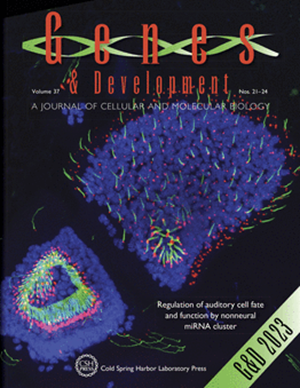Dominant-negative effects of Weaver syndrome-associated EZH2 variants
IF 7.7
1区 生物学
Q1 CELL BIOLOGY
引用次数: 0
Abstract
Heterozygous missense mutations in EZH2 cause Weaver syndrome (WS), a developmental disorder characterized by intellectual disability and overgrowth. EZH2 encodes the enzymatic subunit of Polycomb repressive complex 2 (PRC2), which mediates monomethylation, dimethylation, and trimethylation of histone H3 lysine 27 (H3K27me1/2/3). Most WS-associated EZH2 variants lack functional characterization but are presumed loss-of-function. However, the lack of early truncating mutations in EZH2 led us to hypothesize a dominant-negative mechanism for WS, which was supported by our structural analysis of all known WS-associated EZH2 variants. We isogenically modeled 10 representative variants in embryonic stem cells and showed that they reduce global H3K27me2/3 with concomitant increases in H3K27ac and chromatin decompaction. Notably, the pattern of H3K27me2/3 reductions indicated dominant-negative interference on PRC2 activity even when WS variants were expressed at low levels. RNA-seq identified weakly Polycomb-bound genes that lose canonical PRC1 (cPRC1) occupancy and become derepressed, including several phenotypically relevant growth control genes. Comparative analysis of a gain-of-function EZH2 variant causing growth restriction revealed reciprocal chromatin and transcriptional changes compared with WS-associated variants. Taken together, our findings support a model in which EZH2 variants associated with opposing developmental growth syndromes affect not only H3K27me3 but also intergenic H3K27me2, chromatin architecture, and cPRC1 recruitment.韦弗综合征相关EZH2变异的显性负作用
EZH2的杂合错义突变导致Weaver综合征(WS),这是一种以智力残疾和过度生长为特征的发育障碍。EZH2编码多梳抑制复合体2 (PRC2)的酶亚基,介导组蛋白H3赖氨酸27 (H3K27me1/2/3)的单甲基化、二甲基化和三甲基化。大多数与ws相关的EZH2变体缺乏功能特征,但被认为是功能丧失。然而,EZH2中缺乏早期截断突变使我们假设WS的显性负性机制,我们对所有已知WS相关的EZH2变异的结构分析支持了这一假设。我们在胚胎干细胞中对10个具有代表性的变异进行了等基因建模,发现它们减少了H3K27me2/3,同时增加了H3K27ac和染色质分解。值得注意的是,H3K27me2/3的减少模式表明,即使在WS变异体低水平表达时,PRC2活性也会受到显性负干扰。RNA-seq鉴定了弱polycomb结合基因,这些基因失去典型PRC1 (cPRC1)占用并变得低表达,包括几个表型相关的生长控制基因。与ws相关变异相比,功能获得型EZH2变异引起生长限制的对比分析揭示了染色质和转录的相互变化。综上所述,我们的研究结果支持一个模型,即EZH2变异与相反的发育生长综合征相关,不仅影响H3K27me3,还影响基因间H3K27me2、染色质结构和cPRC1的募集。
本文章由计算机程序翻译,如有差异,请以英文原文为准。
求助全文
约1分钟内获得全文
求助全文
来源期刊

Genes & development
生物-发育生物学
CiteScore
17.50
自引率
1.90%
发文量
71
审稿时长
3-6 weeks
期刊介绍:
Genes & Development is a research journal published in association with The Genetics Society. It publishes high-quality research papers in the areas of molecular biology, molecular genetics, and related fields. The journal features various research formats including Research papers, short Research Communications, and Resource/Methodology papers.
Genes & Development has gained recognition and is considered as one of the Top Five Research Journals in the field of Molecular Biology and Genetics. It has an impressive Impact Factor of 12.89. The journal is ranked #2 among Developmental Biology research journals, #5 in Genetics and Heredity, and is among the Top 20 in Cell Biology (according to ISI Journal Citation Reports®, 2021).
 求助内容:
求助内容: 应助结果提醒方式:
应助结果提醒方式:


